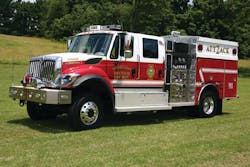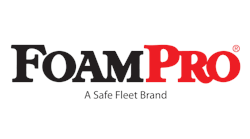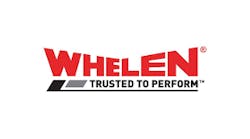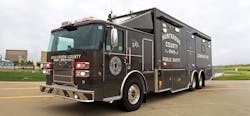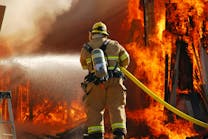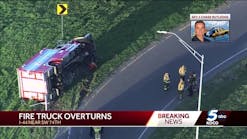One of the major tenants of our “Innovative Rigs on the Street” series is that while the apparatus can come in all shapes, sizes and models, the end result is that new apparatus fully meets the needs of the fire department and the community. With the current economic climate in our country many departments are being asked to provide more services while contending with decreased budgets and funding for new capital expenditures. In some cases the need for a new apparatus is readily apparent; however there is insufficient funding to meet the need. While this may be a temporary setback, there are several alternatives to the purchase of a full custom chassis apparatus, including the use of a commercial chassis, especially when a short wheelbase four-door cab unit is required. In last month’s article, we featured a Class-8 commercial chassis pumper for the North Bailey, NY, Fire Department. In this month’s article we travel to Sperryville, VA, to detail their well-designed apparatus designated as Attack 2. Sperryville is located in Rappahannock County, VA, near the Blue Ridge Parkway and operates a unique apparatus fleet of new and used units.
The Sperryville Volunteer Fire Department was chartered in 1947 to become the second fire company in Rappahannock County. Their first apparatus was a 1938 USA model 750 gpm pumper built for the US Army at Fort Holibird, MD. Like many apparatus of that era there was no windshield, cab doors or roof for protection against the elements. After operating several used units purchased from other departments, the department received their first new apparatus in 1957 with the delivery of an FWD model S-750 pumper equipped with twin booster reels and a much-needed closed cab.
Over the years the Sperryville Volunteer Fire Department has operated an apparatus fleet with a combination of both new and used units. The department acquired a 1975 Kenworth pumper tanker with Howe bodywork from Long Grove, IL, and placed the unit into service as Tanker 2. At one time the department operated several units acquired from Fairfax County, VA, including a 1971 Seagrave PB model 1000 gpm pumper and a 1986 Pierce Arrow 1250 gpm pumper that was operated by the department in McLean, VA.
Today, the Sperryville Volunteer Fire Department is under the command of Chief Richie Burke and responds annually to approximately 200 incidents. The department maintains an active membership of 25 personnel with six pieces of apparatus. The current fleet of apparatus operates from a single station and consists of a 1995 Pierce Lance 1500 gpm pumper that was formerly operated by the Columbia Engine Company in Oceanside, NY. Rescue Engine 2 was acquired from Oceanside during 2007 and is equipped with hydraulic rescue tools, air bags, and stabilization jacks along with a full compliment of engine company equipment. Engine Tanker 2 was purchased new during 2006 and is a Spartan Gladiator 4x4 chassis with bodywork by Four Guys Fire Apparatus. This unit carries a 1500 gpm pump, 1500-gallon water tank together with a 30-gallon foam tank and three quick dumps. Both of these units feature stainless steel bodies and air-actuated aluminum tread plate hose bed covers.
Other units currently operated by the department include a 1983 and 1997 Ford F series pickups, equipped with slide-on skid units for brush fire duty, and a 2010 Ford F-350 four-door cab unit assigned as Utility 2. The stations newest unit operating as Attack 2 is a 2010 International four-door cab pumper with bodywork constructed by Four Guys Fire Apparatus.
The first due area for Company 2 is quite rugged and required the design of a four-wheel drive chassis with adequate ground clearance to operate in off-road locations. Working with the department’s apparatus committee Chief Burke developed a set of bid specifications that clearly outlined the design requirements for the new apparatus without restricting competitive bidding. The department received four bids on the project with the result being a contract award to Four Guys for the new rig. From this point the fire department worked closely with Bob Purcell, the local Four Guys representative, during the manufacturing process to insure that all of portions of the specifications were properly executed.
The result of this process was the delivery of a 2010 International 7400 model four-wheel drive chassis that is assigned as Attack 2. This unit is powered by an International Maxxforce 9 engine rated at 330 horsepower through an Allison Generation IV model EVS-3000 five-speed automatic transmission. The chassis design called for a front axle rating of 12,000 pounds with a Meritor RS-23-160 rear axle rated at 23,000 pounds. The transfer case is a Meritor model T-4210. Both the front and rear axles are equipped with spring suspension with S-Cam brakes on each axle. Auxiliary braking is provided by a combination engine and exhaust brake.
Attack 2 is built with a wheelbase of 207 inches and an overall length of 26 feet, 11 inches. The International model 7400 cab provides seating for five personnel with four seats equipped with self-contained breathing apparatus (SCBA) brackets. In order to provide adequate ground clearance, the front overhang is 42 inches with a rear overhang of 72 inches. The rear angle of departure is 26 degrees with an overall body length of 109 inches. The overall travel height of the apparatus is 9 feet, 10 inches.
The front of the apparatus is equipped with a 10-inch bumper extension and outfitted with a custom fabricated stainless steel wraparound bumper. The extension is equipped with a Federal mechanical siren, LED style Roto-Ray together with an Akron model 3463 remote-control monitor fed by a 2-inch discharge. The monitor is rated for 125 gpm and is capable of being supplied by the CAFS foam system.
Four Guys provided and installed several components on the chassis, including a seat-belt monitoring system, vehicle data recorder, interior cab console and compartments under the rear cab doors to accommodate equipment storage and a booster reel. The three forward-facing seats are mounted on an enclosed storage compartment and skid-plate protection was installed under the side-mounted chassis diesel fuel tank.
The apparatus warning-light package consists of a Whelen Ultra Freedom roof-mounted LED light bar with four mini LED lights positioned on the front grill. Other warning lights consist of Whelen LED lights along the front sides and rear of the apparatus cab and body including on the upper-body compartments on both sides. Whelen scene lights are provided at the rear of the body to illuminate this area, which is automatically activated when the unit transmission is placed in reverse. Additional scene lighting is provided by three Fire Research Optimum 150-watt, 12-volt lights that are located at the front, center of the cab roof, as well as two top-raise telescopic lights mounted above the pump enclosure on each side.
A Voyager color back-up camera is provided at the rear body, with a Whelen LED arrow stick light. The rear body is equipped with red and yellow Chevron stripping and carries a folding ladder, roof and 20-foot extension ladders together with three 8-foot lengths of flexible hard suction hose.
The body is fabricated from stainless steel and is provided with seven enclosed body compartments utilizing a mixture of both painted stainless steel and Robinson roll-up shutter door at the center rear body. Two upper body compartments provide storage for long handle tools and other equipment. The compartments are well designed and laid out using an assortment of slide trays and adjustable shelves with Performance Advantage Company PacTrac and brackets utilized to secure adapters, hand tools, extinguishers, smoke ejector and chainsaw equipment. The rear hose bed is equipped with 700 feet of 4-inch and 300 feet of 3-inch hose, which is secured by air-operated aluminum tread plate hose-bed covers. Attack 2 is equipped with three speedlay hose beds carrying 200 feet of 1.75-inch hose in the lower two beds with 150 feet of 2.5-inch attack line in the upper bed, which supplies a Task Force Blitz Fire monitor. Each of these preconnected attack lines is capable of providing either water or CAFS foam solution.
The fire pump on this unit is a Waterous model CXVK single-stage rated at 1000 gpm equipped with Pneumax CAFS together with a Foam Pro 2001 injection system that is capable of supplying the front bumper turret, three speedlays, booster reel and the driver’s side 2.5-inch discharge. The fire pump intakes consist of two 6-inch inlets and a 5-inch rear intake equipped with an auto-fill valve control. The left side pump panel is provided with a 2.5-inch discharge with a 3-inch discharge located at the right side panel that is equipped to supply a large diameter hose. A 500-gallon water tank is provided to support initial attack operations together with a 30-gallon Class A foam tank. Auxiliary 2.5-inch gated intakes are provided on both sides of the pump panel. The pump panel is 48 inches wide and is fabricated from stainless steel with the upper panels covered in black vinyl.
The Sperryville Volunteer Fire Department set out to design and operate a short wheelbase attack apparatus to protect their first due area. Attack 2 is an excellent example of a well-developed piece of equipment that took many months of planning. I would like to thank Chief Richie Burke and Bob Purcell who assisted with technical information on this apparatus. Special thanks to Mike Sanders who provided all of the photos for use in this article.
TOM SHAND is a 37-year veteran of the fire service having served with departments in Maryland, Pennsylvania and New York. He has worked in the fire apparatus industry since 1985, including 15 years with Saulsbury Fire Apparatus. He is a contributing editor to Fire Apparatus Journal and Firehouse Magazine and works with Mike Wilbur at Emergency Vehicle Response. He co-hosts the Apparatus Architects podcast with Wilbur, based on their column in Firehouse Magazine.
